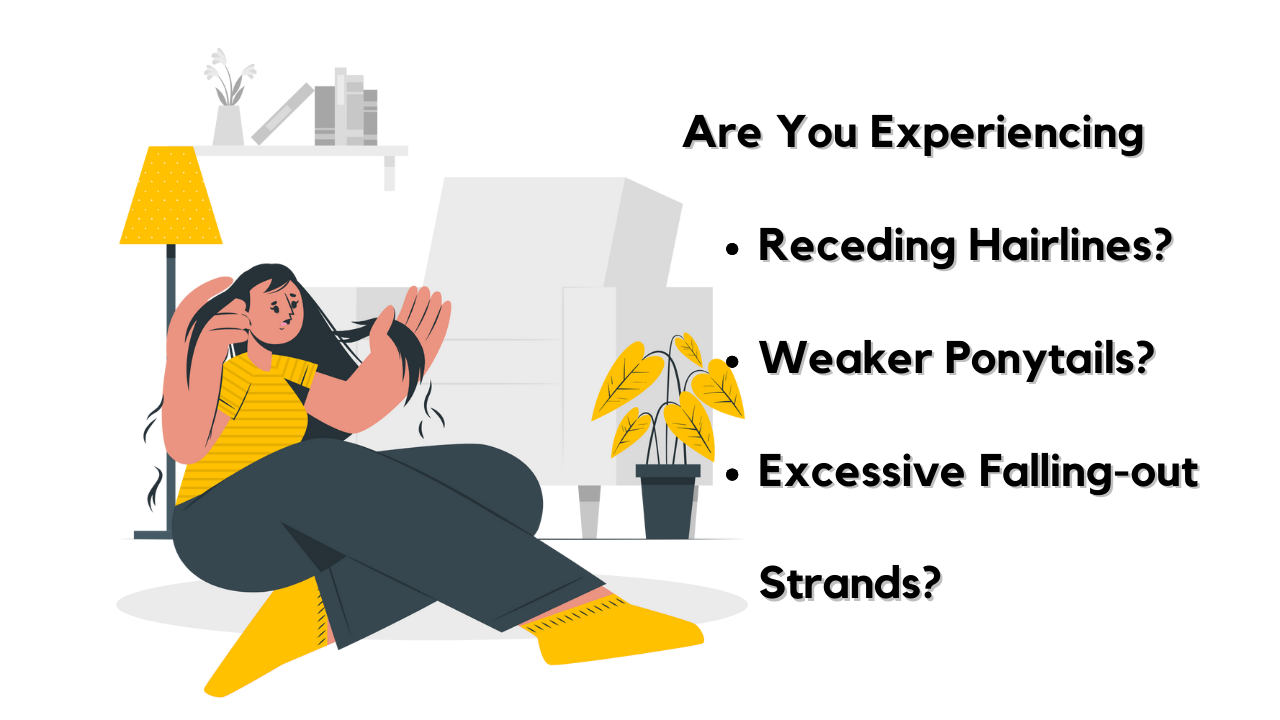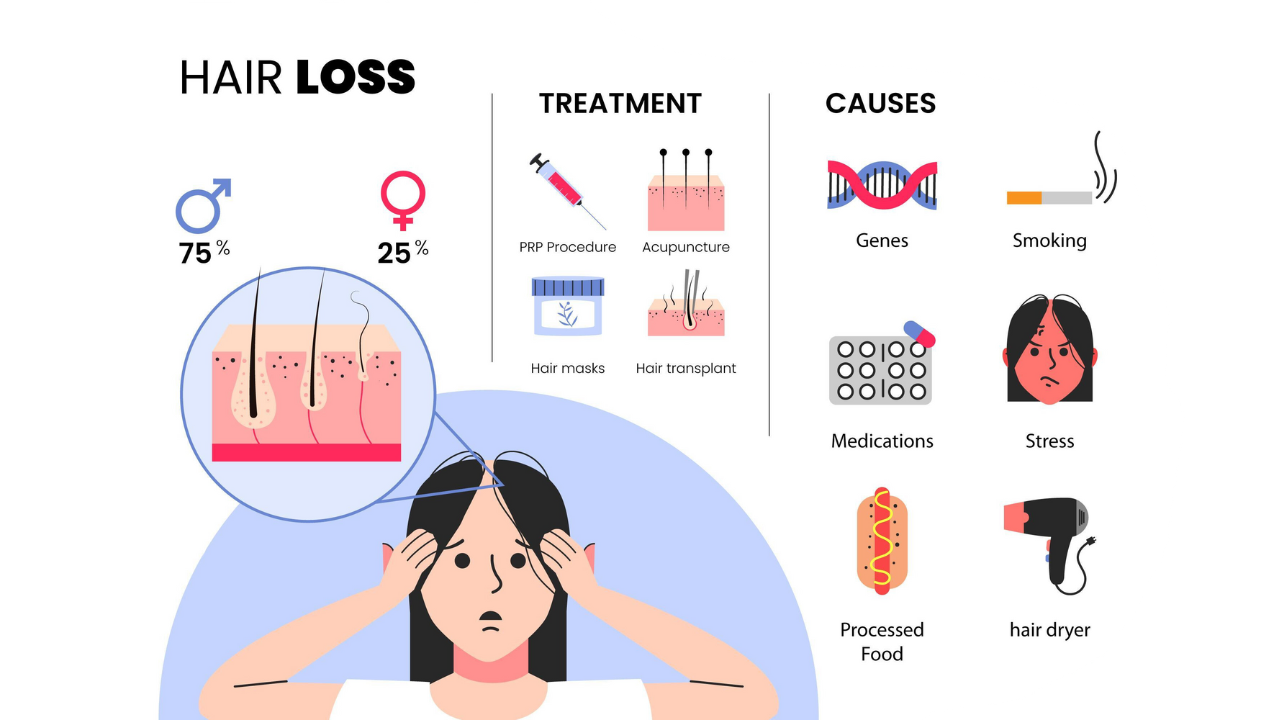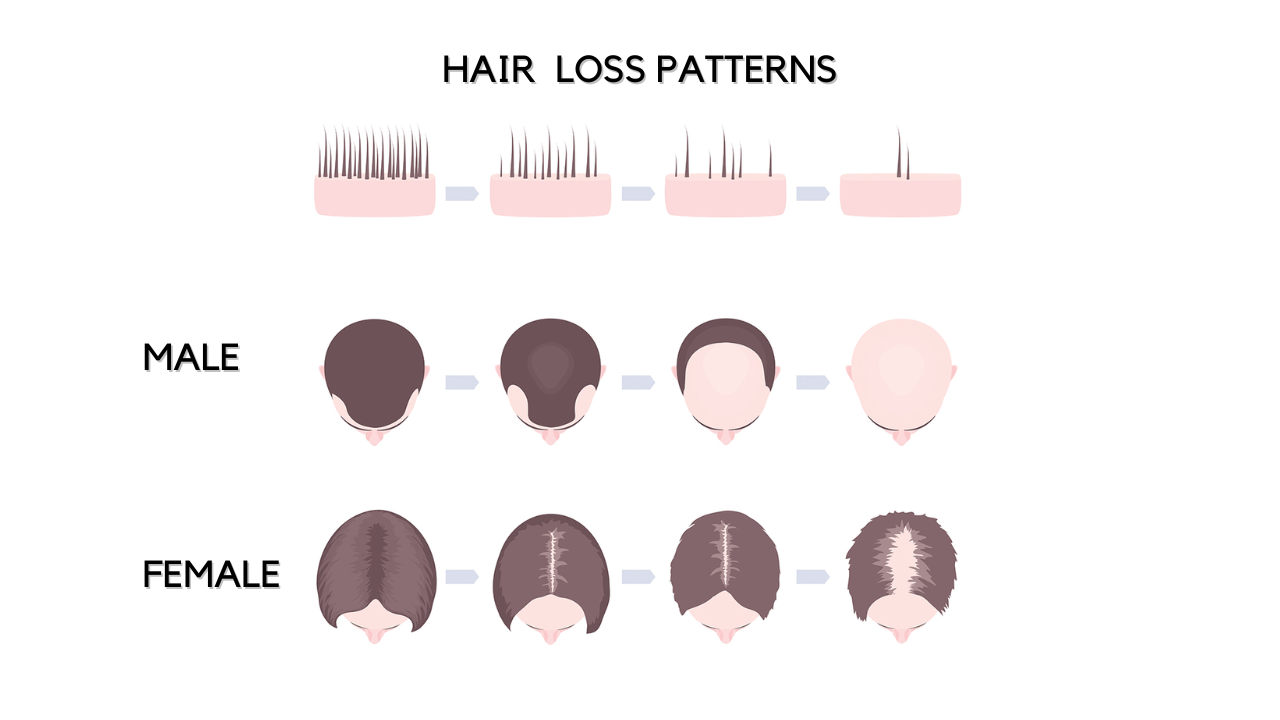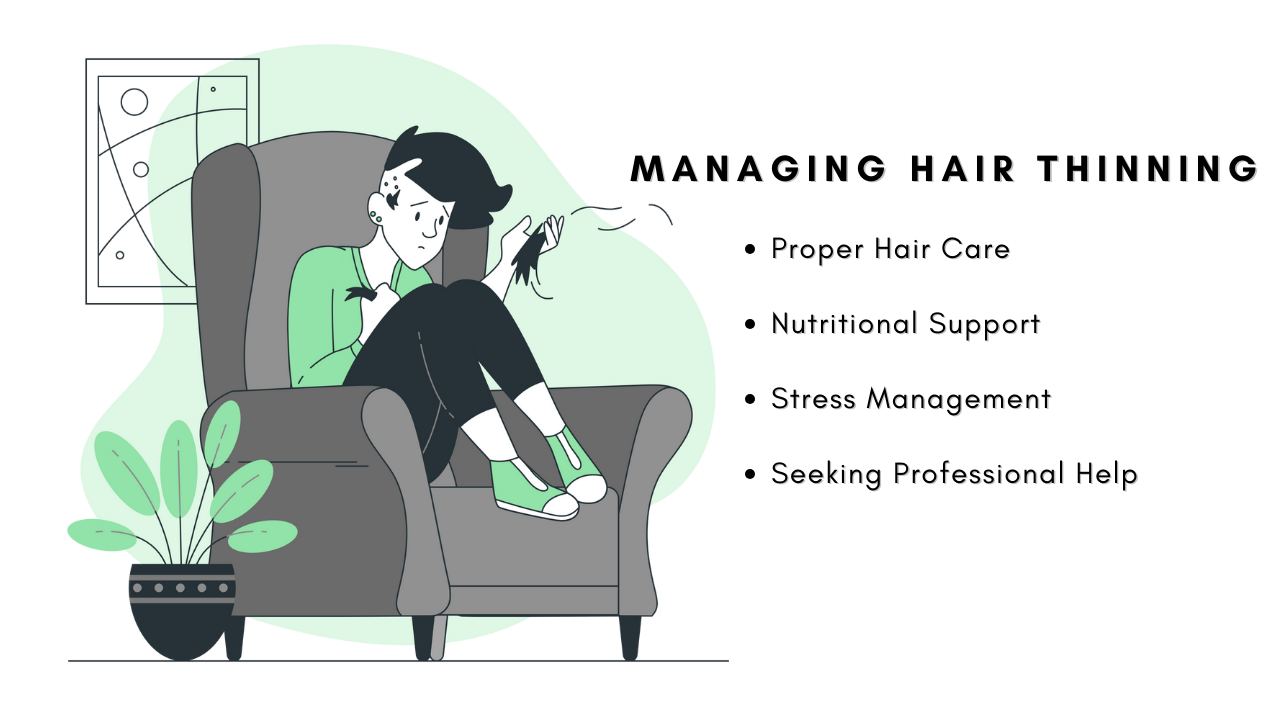Table of Contents
Spotting hair shedding can often be the initial warning sign of thinning hair. It often goes unnoticed until it's advanced to stages commonly seen in male pattern baldness. The signs of thinning hair aren't always about clumps of hair on your pillow or in your shower drain, sometimes it can be subtle. You might notice changes in your hair shaft, like hair strands appearing thinner, less full, and less able to style. When you see these signs, it's vital not to panic - stress can exacerbate hair loss! Remember, there are numerous hair loss treatments available, many of which can effectively reduce and possibly even reverse hair loss. So, if you're facing these signs, don't hesitate to reach out to a hair care professional who can recommend the best actions for you.
Recognizing Early Signs of Hair Thinning

Taking prompt action once thinning hair signs are spotted is essential for proper prevention and treatment. Being aware of changes on the scalp and locks, as these may happen subtly over time, can be valuable in protecting your mane from potential balding. Important symptoms to look out for include receding hairlines, weaker ponytails, or excessive falling-out strands.
Identifying risk factors quickly after recognizing any such clues could have a major impact in minimizing Loss of hair.
Alright folks, let's talk about something that’s been on our minds lately - hair shedding. It's totally normal to lose a few strands here and there, but when it gets excessive, it can be a bit scary, right? Now, if you've noticed a sudden hair loss, don't freak out just yet. It might be due to stress, or it could be the early signs of male pattern baldness. But hey, no matter what the cause, remember, there’s always a solution. A ton of hair loss treatments are available out there to help you curb this issue. What’s important is to act before it leads to further hair loss. Stay vigilant, folks. If you notice patchy hair loss, that’s the time you should definitely see a specialist. Bottom line? Keep an eye on your glorious mane, and take action when necessary. No one deserves to lose their crowning glory!
Receding Hairline
For those with a receding hairline around the temples, which is especially common in men aged 30-40, it can be an early sign of thinning and balding. It’s important to notice this change as soon as possible so that you take steps to prevent loss. Hair styling such as having longer length down are helpful for disguising what’s occurring while reducing any worries associated with decreasing thickness of hair strands.
For my fellow dudes out there experiencing a receding hairline around the temples, listen up. This is often a sneak peek at what's commonly known as male pattern hair loss. We're talking about the classic "M" shape that becomes more pronounced in men aged 30-40. It's like a secret handshake but not the kind you want. Spotting this change early is your first line of defense in preventing excessive hair loss before you start finding more of your mane in your shower drain.
But don't panic, there are plenty of hair loss treatments out there which could be your saving grace. While you're getting things sorted, longer hairstyles can be a solid ally in your fight against treating male pattern baldness. It's a bit like a disguise for your scalp, minimizing any worries about your thinning hair. Stay strong, fellas. We're all in this together.
Thinner Ponytail
If you notice that your ponytail looks and feels less full than before, it could hint hair thinning. A decrease in the thickness of a ponytail indicates a loss in volume and density. This can have different sources such as hormonal imbalances or stress-related problems. To gain back more hair growth, these underlying causes must first be addressed.
It is important to keep an eye out for sudden changes concerning your hairstyle’s volume. If noticed promptly enough there will still be time to treat male or female pattern baldness.
Have you ever taken a closer look at your visible scalp when you're fixing up that ponytail? If the hair feels lighter or you're noticing some general thinning, don't panic! It's actually pretty common and can be linked to stress related hair loss. Trust me, you're not alone. Stress can be sneaky, and it loves to mess with our hair density.
But here's the good news! Treating hair loss is totally doable and there are loads of options. Yeah, it might feel like a massive challenge when you're staring at the shower drain, but remember, hair regrowth is achievable. It's all about understanding what's going on underneath and getting to the root of the issue. So, let's tackle this together, okay? It's time to bid farewell to the thinning and hello to a future of fabulous, thick hair.
Excessive Shedding
Losing anywhere from 50 to 100 hairs each day is considered normal, yet shedding far more than this could be a hint of hair thinning. You may spot random strands on your bathroom floor or clumps in the shower drain.
If you are concerned about severe loss of locks, it would be wise to get examined by an expert. This will help you find out what might have caused it as well as think over possible treatments together.
Common Causes of Hair Thinning

Hair thinning can be caused by a variety of factors, some which are more predominant than others. An imbalance in hormones, pressure and tension as well as any existing medical conditions may all lead to hair loss. According to "How to beat hair loss" by Dr. Antonio Armani, MD, "The most common factor is your own genes, which means that you inherit the tendency to lose your hair."
By understanding the possible causes for your condition you will able to take appropriate action towards restoring its healthiness again.
Hormonal Imbalances
Hair thinning that is linked to hormonal fluctuations, like during menopause or postpartum period, can be attributed to a decrease in estrogen production. This hormone plays an essential role for hair growth and its reduction may cause weaker strands of hair.
Medical conditions such as thyroid issues, polycystic ovary syndrome and anemia could contribute towards these imbalances causing loss of locks - meaning it’s important to get the correct diagnosis if you suspect this issue is your problem!
Stress and Anxiety
Stress and anxiety can have a devastating effect on hair, especially in women over 40. When experiencing psychological distress or neglecting self-care routines the body’s response is to decrease the production of follicles – leading to thinning hair.
Yoga, meditation and deep breathing are all great ways to reduce tension levels which will keep your hair healthy as well. Don’t forget important basics such as getting enough rest, eating balanced meals daily plus regular physical exercise for added stress relief. These factors also play an imperative role in maintaining strong locks!
Medical Conditions
Hair thinning and loss can be caused by medical conditions, such as thyroid disorders, malnutrition or alopecia areata. Imbalances of hormones due to a thyroid disorder can cause hair to become thinner. Not having the right vitamins and minerals may lead to poor nutrition which could result in an overall decrease in strands of hair on your head. Alopecia areata is another health condition that leads to it since this autoimmune disease causes the body’s own immune system attacking its follicles causing bald spots across the scalp area or even complete absence of all locks.
If you suspect any type of serious issues behind why there’s thinning hairs then it’s important for someone suffering from those problems talk with their doctor about being properly diagnosed so they know how best treat them moving forward.
Hair Thinning Patterns and Types

Hair thinning and loss patterns vary due to the underlying cause, which may involve a combination of different factors. We will be discussing three hair types: androgenetic alopecia, traction alopecia, as well as telogen effluvium, all of which have unique symptoms for identification purposes.
Understanding these distinct forms of balding can help individuals recognize their specific issue so they can find appropriate treatment solutions.
Androgenetic Alopecia

Thinning hair, male pattern baldness and female pattern hair loss all have their root in the condition known as androgenetic alopecia. It is a type of genetic-based hair loss that impacts both males and females but is more severe among men, usually found at the part line, temples or crown area due to hormonal changes affecting how much nutrients are provided for growing strong strands of hair.
Dihydrotestosterone (DHT) can be blamed since its increase results in shrinkage of follicles making them incapable producing thicker locks like before. By understanding what triggers such affliction people would take proper steps which could lead towards reversing this process causing thinning tresses again grow lush healthy ones!
Telogen Effluvium
Telogen effluvium is a type of temporary hair loss that manifests itself through thinning on the scalp. It can be triggered by physical or emotional shock, such as an illness, sudden weight change or life-changing event. Fortunately if proper care and attention are given to addressing any issues causing this condition then it’s possible for normal hair growth to resume once the stressor has been dealt with.
Traction Alopecia
Traction alopecia is a form of hair thinning associated with the tension caused by tight hairstyles, chemical treatments and heated styling tools. This type of baldness usually manifests around the edges and temples as prolonged strain on follicles can weaken them to an extent that they eventually fall out.
In order to prevent it from occurring one should take precautionary measures such as utilizing gentle methods when styling their locks, using mild products only plus giving regularly breaks between tighter hairdos or usage heat based appliances for styling purposes.
Tips for Preventing and Managing Hair Thinning

When dealing with thinning hair, it is important to take action in order to preserve your locks and control the problem. Good hygiene for your hair combined with a balanced diet that supplies essential nutrition as well as managing stress are all crucial steps one can take to protect their mane from damage or loss.
We will go into detail regarding these practices below:
Proper Hair Care
When taking care of your hair, it is important to use mild products and avoid putting too much heat or tight hairstyles on it. Incorporating scalp serums and oils can be beneficial in nourishing the strands as well as protect them from damages such as thinning or loss of hair follicles. Be aware that some items may contain potentially toxic components. Go for gentler alternatives whenever possible. In summary, having a healthy head of locks requires one’s commitment to using appropriate tools while also considering their delicate nature when styling them up!
Nutritional Support
In order to stimulate healthy hair growth and prevent thinning of the hair, proper nutritional care is essential. Having a nutritious diet full of necessary vitamins, minerals and nutrients can assist in maintaining your hair follicles’ healthiness as well as help generate new hairs.
Taking supplements can be key to nourishing your hair. They can improve the health of your strands and reduce issues like baldness or patchy areas caused by poor nutrition. By getting all the nutrients you need, you can keep your hair strong and vibrant. This also protects against damage from not meeting dietary requirements
Stress Management
Managing stress is vital to prevent hair thinning due to anxiety and worry. Relaxation practices, for instance yoga, meditation or controlled breathing can be useful in reducing pressure levels and diminishing loss of tresses.
Catching enough restful sleep, partaking in regular exercise and focusing on personal care are all beneficial habits that promote a decrease in tension while aiding healthy growth of locks. Good control over stress can successfully assist one from losing their hair as well as increase general healthiness altogether.
Seeking Professional Help

If you think that your hair is becoming thinner or starting to fall out, it’s important to get expert help. Consulting a doctor can allow for an accurate diagnosis of the cause behind hair loss and give advice about possible treatments.
Despite all the solutions available online at home, seeking professional medical counsel on balding still remains essential in order to receive effective care related directly to one’s specific condition concerning their locks.
When to See a Doctor
If you are experiencing any sort of hair thinning or loss such as a receding hairline, sudden shedding, patchy balding spots and/or increased amounts when brushing or shampooing it is recommended to seek medical advice. Consulting with an expert promptly can help identify the cause so that proper treatment methods may be put in place before things become worse. Don’t let your concerns go unnoticed, speak up right away about your feelings regarding possible hair issues! Taking action early will ensure better results for yourself rather than waiting until serious damage has been done by continuing on without knowledge and aid from professionals specializing in these conditions.
Treatment Options
When dealing with hair thinning, it is vital to consult a professional in order to choose the optimal treatment for your individual situation. Possible remedies range from minoxidil and finasteride (both approved by the FDA), through hair transplantation surgery, low-level laser therapy - among other options. Each of which offering its own set of benefits as well as drawbacks. By considering all possible approaches when tackling this problem you can be sure that you’ll find an effective solution for rejuvenating both the health and amount of your precious locks!
Summary
Early detection is the key to successfully managing hair thinning. Knowing what signs of thinning or loss to look out for, such as an increase in shedding and a widening part line, can help you take proactive steps towards regaining control over your hair’s health. As long as proper hair care practices are followed, nutrients replenished and stress managed accordingly then it should be possible to minimize damage. If concerns arise that cannot be addressed without professional assistance there are treatments available which one could explore too if required - don’t delay seeking advice!
Frequently Asked Questions About Hair Thinning
How do I know when my hair is thinning?
Thinning hair can be identified by looking out for gradual thinning on top of the head, circular or patchy bald spots, sudden loosening of hair, full-body hair loss, and patches of scaling that spread over the scalp.
Additionally, signs of thinning hair may also include filling up a hairbrush with more hair or noticing more when washing your hair as well as feeling a thinner ponytail.
Is my hair thinning or just fine?
If you start noticing a gradual decline in the quantity of strands and an increased visibility on your scalp, it could be a sign that your hair is thinning. Check if there are changes over time regarding both quality and shape when assessing hair loss. It’s important to keep track of these factors as they can indicate whether or not one has been experiencing hair thinning.
Am I losing hair or am I paranoid?
It is common for a few stray hairs to end up on your hair tie, so don’t panic about it.
But if there are noticeable amounts of strands being shed while combing or washing, this might be an indication that you’re actually experiencing some degree of thinning, not just in your head but potentially also along the rest of your body. So pay attention and take note. Losing too much hair could serve as early warning signs for something more serious down the line.
If you're noticing more strands than usual on your pillow when you wake up, or if distinct areas of "patchy hair loss" are appearing on your scalp, it might be time to take action and consult a hair loss specialist. It's super normal to shed a few hairs daily, but if you're losing significantly more, it might be a symptom of a more serious condition. Always better to be on the side of caution, right?
What are the common causes of hair thinning?
Hair thinning is attributed to imbalance in hormones, stress and tension as well as medical issues.
What are some types of hair thinning patterns?
The three primary patterns of hair thinning are androgenetic alopecia, telogen effluvium, and traction alopecia. These distinct types of hair loss affect individuals differently due to the nature of each disorder. They all involve a reduction in thickness or amount of one’s hair.
Key Takeaways
-
Recognize early signs of hair thinning to prevent and treat it.
-
Monitor the volume of your ponytail, excessive shedding may indicate an underlying problem.
-
Causes include hormonal imbalances, stress & anxiety, medical conditions. Prevention through proper care habits & nutrition. Seek professional help for treatment options.










